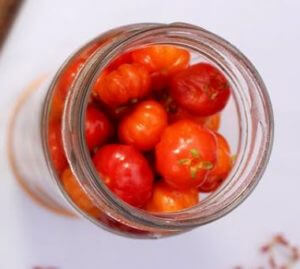Preserve Your Veggies Without Freezing: Whole Tomatoes
Buying fresh produce always seems to be a waiting game–one that if you blink, your food will go from ripe to rotten all too soon. However, you can preserve the food how people used to years ago-in salt. One of the best foods to preserve this way is the tomato. Keep them ready for sauce or stock, and no need to remove the extra salt!
The following is an excerpt from Preserving Food Without Freezing or Canning by The Gardeners & Farmers of Terre Vivante. It has been adapted for the web.
Above a certain concentration of salt in food, microorganisms cannot develop and thus the preservation of food is assured.
While preserving with salt seems a relatively ancient process, it is not as old as the methods we have described so far. At one time, salt was mainly used for preserving meat, fish, and butter; every rural household had a salt tub. Today, salt still is used for fish, such as cod or anchovies, as well as for pork and butter. Among vegetables, we sometimes salt green beans, herbs, and vegetable mixtures for soup stock.
There are two main disadvantages to preserving food with salt:
- The salt must be removed from most foods before consuming them, which usually requires lengthy soaking and repeated rinsing that also eliminate some of the nutrients;
- If the salt is not completely removed, we risk consuming more than is considered healthy these days.
However, for preserving foods that we eat in small quantities, or that don’t need much soaking and rinsing, salt has its place. It is one of the best ways to preserve fish, for which other methods tend to be less convenient. Green beans seem to be the vegetable that best lends itself to being preserved with salt.
There are many versions of this method of preservation, and we have included in this chapter several of the most common ones. Yet, among all the foods preserved with salt, mixed vegetables are perhaps the most appealing: no salt need be removed; they do not cause you to eat too much salt; and they make instant stock for soup.
 Whole Tomatoes
Whole Tomatoes
Ingredients
- Tomatoes
- Olive oil
- Salt
- A saucepan
- Glass jars and lids
Procedure
- Make a brine (one-quarter cup salt to one quart of water), and bring it to a boil.
- Allow to cool.
- Choose firm tomatoes, preferably (‘Campbell’ variety, for example), wash and dry them carefully, and put them in glass jars.
- Pour in the cooled brine, up to one and a quarter inches below the rim, and fill in the remaining space with olive oil to cover.
- Close the jars airtight and store them in a cool place.
These tomatoes will keep for nine to ten months; use them for sauces.

 Whole Tomatoes
Whole Tomatoes